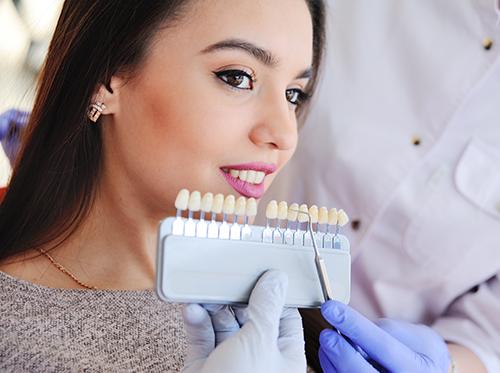Is There an Act Three for Our Teeth?
- posted: Apr. 23, 2024
Act One: Those 20 adorable baby teeth which begin arriving when you’re about six months old and are probably gone by the time you’re twelve. Act Two: The 32 (if you Read More
My gums are shrinking!
- posted: Apr. 09, 2024
Have you ever looked in the mirror and noticed that your teeth looked longer? Does it seem like your gums are shrinking? This condition is called recession—many adults have it. Read More
Planning Your Vegetarian Diet with Your Oral Health in Mind
- posted: Apr. 02, 2024
If you’ve been following a vegetarian or vegan diet, you know that there’s much more to living a healthy life than simply avoiding meat products. Making sure your diet includes Read More
Adult Mouthguards
- posted: Mar. 26, 2024
You make sure your daughter wears her mouthguard to every soccer practice. Your son doesn’t step on the basketball court without his. Why not protect your smile as well? Athletes of Read More
DIY Teeth Whitening
- posted: Mar. 19, 2024
We all want our best and brightest smiles, and today there are many options we can explore at home to make those beautiful smiles a reality. Whether it’s healthy habits, Read More
Go Green for St. Patrick’s Day
- posted: Mar. 12, 2024
Millions of people, around Peachtree City, Georgia and beyond, wear green on St. Patrick’s Day so they can show their spirit for the holiday and avoid getting pinched. While it Read More
March is National Nutrition Month!
- posted: Mar. 05, 2024
While you don’t have to wait to start eating right, March is the month the Academy of Nutrition and Dietetics asks everyone to pay special attention to what goes into Read More
Is Coffee Damaging Your Smile?
- posted: Feb. 27, 2024
Coffee is one of the most popular drinks in the world. Many people have a cup, or two, or even three a day. It’s common to drink it in the Read More
Thirsty? We Have Some Ideas on Tap
- posted: Feb. 20, 2024
No, we don’t mean the latest foamy offering from your favorite microbrewery. When you’re thirsty, one of the best options available is literally at your fingertips—tap water, straight from your Read More
The Transformation of Valentine's Day
- posted: Feb. 13, 2024
Did you know the actions leading to the beginnings of Valentine's Day were actually centered on the avoidance of war? A Catholic priest named Valentine defied the orders of the Read More
Dentin Tooth Sensitivity Treatments
- posted: Feb. 06, 2024
Dentine hypersensitivity can be described as a sharp and sudden pain caused by cold food and beverages. It’s present in more than half the population and result from receding gums Read More
Whitening Before Veneers—A Bright Idea?
- posted: Jan. 30, 2024
It’s time. You’ve decided. You’re going to get veneers. Whether it’s to repair a cracked or chipped tooth, to cover discoloration brought on by a root canal or medical condition, Read More
Make Your Smile Dazzling For Your Wedding!
- posted: Jan. 23, 2024
Planning a wedding can be a highly stressful time. the doctor and our team want to support you in this process by helping you achieve a beautiful, bright smile. Wedding Read More
Suffer from tooth discoloration? Don’t panic!
- posted: Jan. 16, 2024
Like many other parts of the human body, teeth age. You may look at old photos and realize your smile was significantly brighter in the past than it is now. Read More
Proper Brushing Techniques
- posted: Jan. 09, 2024
Brushing your teeth properly removes the food particles and bacteria that can lead to tooth decay and gum disease. However, you do not want to scrub your teeth or gums Read More
Locations
1125 Commerce Drive Suite 100
Peachtree City, GA 30269, US
Hours of Operation
8:00 am - 5:00 pm
8:00 am - 5:00 pm
8:00 am - 5:00 pm
8:00 am - 5:00 pm
Closed
Closed
Closed

















